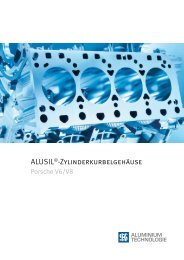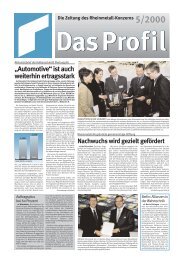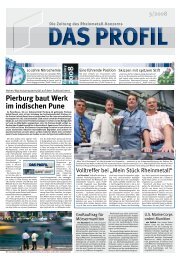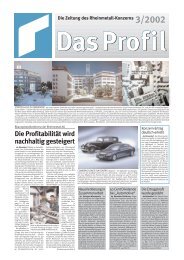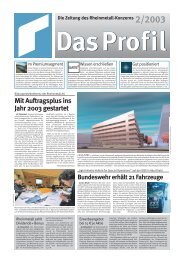1/2008 - KSPG AG
1/2008 - KSPG AG
1/2008 - KSPG AG
You also want an ePaper? Increase the reach of your titles
YUMPU automatically turns print PDFs into web optimized ePapers that Google loves.
The latest news from the Rheinmetall Group<br />
Regionalized<br />
The organizational structure<br />
of Rheinmetall Defence necessitated<br />
a re-organization of the group’s<br />
worldwide sales activities (page 3).<br />
1/<strong>2008</strong><br />
More benefit<br />
Giving customers a genuine<br />
benefit – this is what the qualified<br />
workforce ob benntec Systemhaus<br />
GmbH in Bremen seeks to do (p. 9-11).<br />
Rheinmetall and Krauss-Maffei Wegmann to supply Bundeswehr with new IFV<br />
Go-ahead for the new Puma<br />
Berlin/Düsseldorf. The German Bundestag’s<br />
budget committee recently<br />
cleared the way for the procurement of<br />
405 new Puma infantry fighting vehicles<br />
for the Bundeswehr. For Düsseldorfbased<br />
Rheinmetall <strong>AG</strong> and Krauss-Maffei<br />
Wegmann GmbH & Co. KG of Munich,<br />
the order represents a combined total of<br />
some € 3 billion in gross sales.<br />
Rheinmetall and Krauss-Maffei Wegmann<br />
each hold a 50% stake in the<br />
company tasked with the project, PSM<br />
GmbH of Kassel. Both hailed the decision<br />
as a crucial step in re-equipping<br />
the German Army for the future as well<br />
as being vitally important to the German<br />
defence industry and a whole host of<br />
medium-sized subcontractors. With its<br />
unique balance of tactical and strategic<br />
mobility, survivability and lethality, the<br />
Puma gives the Bundeswehr a state-ofthe-art<br />
infantry fighting vehicle systematically<br />
tailored to current and future<br />
operational requirements of the German<br />
military both at home and abroad.<br />
Successful firing<br />
of Millennium gun<br />
Zurich/Copenhagen. Oerlikon Millennium<br />
35mm naval gun systems successfully<br />
engaged surface and air targets<br />
during live-fire trials aboard HDMS<br />
Absalon, the Royal Danish Navy's first<br />
Absalon-class flexible combat support<br />
ship. The trials took place during the<br />
first and third weeks of November 2007.<br />
The test firings formed part of sea trials<br />
and Sea Acceptance Tests (SAT) off<br />
the Danish coast. Practice ammunition<br />
Today the Puma is poised to significantly expand the Bundeswehr’s capabilities spectrum.<br />
“We’re extremely pleased that the<br />
Puma has cleared the final parliamentary<br />
hurdle. This is the biggest single order<br />
in the history of our company, and<br />
definitely confirms our status as Europe’s<br />
top supplier of army technology”,<br />
states Klaus Eberhardt, chairman of the<br />
executive board of Rheinmetall <strong>AG</strong>.<br />
and Oerlikon Ahead ammunition – like<br />
the guns, both made by Rheinmetall<br />
subsidiary Oerlikon Contraves – were<br />
used to engage both air and surface targets.<br />
Danish personnel operated the<br />
guns, having already received operation<br />
and maintenance training during<br />
the summer of 2007. According to DALO<br />
(Danish Defence Acquisition and Logistics<br />
Organization), the firings with the<br />
two Oerlikon Millennium guns were<br />
successful and its SAT was completed<br />
during the third November week. The<br />
HDMS Absalon is equipped with two<br />
Millennium guns, one forward and one<br />
The Bundestag set the project in motion<br />
in September 2002 when it awarded<br />
a development contract for the new<br />
IFV, followed in 2004 by a € 350-million<br />
procurement order for five pre-series<br />
vehicles and related services.<br />
These vehicles are currently undergo-<br />
(Continued on page 15)<br />
aft. The Royal Danish Navy is the launch<br />
customer for series production of the<br />
Oerlikon Millennium naval gun system,<br />
having ordered six guns in 2004 with an<br />
option for a further four. Production for<br />
further customers is also underway. Absalon-class<br />
final SAT for the Millennium<br />
guns and the 127mm gun is planned for<br />
week 13 or 14 in <strong>2008</strong>. The Royal Danish<br />
Navy decided to equip its Absalon-class<br />
ships and patrol vessels with Millennium<br />
because of Oerlikon’s state-of-theart<br />
Ahead ammunition and revolver gun<br />
technology, both of which assure an<br />
outstanding multi-mission capability.
Newsline<br />
Rheinmetall with strong increase in sales and profit<br />
Order intake leaps by 19 percent<br />
Düsseldorf. For the first nine months<br />
of 2007, Düsseldorf-based Rheinmetall<br />
<strong>AG</strong> again showed dynamic growth in all<br />
its key financial indicators. Sales and<br />
order intake rose clearly and corporate<br />
profits improved even more appreciably.<br />
EBIT climbed over 40 percent to<br />
€ 157 million, net income jumped from<br />
€ 54 million to € 79 million. For all of<br />
2007, Rheinmetall counted on significant<br />
growth and much upgraded results.<br />
Says Klaus Eberhardt, Rheinmetall<br />
<strong>AG</strong>’s CEO: “Rheinmetall is firmly on<br />
track for achieving its 2007 goals. On<br />
the basis of the contracts already<br />
booked we will sustain our organic<br />
growth and continuously enhance the<br />
value of the group.”<br />
In the first three quarters (3Q) of 2007,<br />
Rheinmetall generated group sales of<br />
€ 2,841 million (up from € 2,570 million),<br />
equivalent to an increase of 11 percent<br />
versus 3Q/2006. The Defence sector<br />
outgrew year-earlier sales by 24 percent,<br />
the Automotive sector advanced<br />
by 3 percent. Order intake surged, too;<br />
groupwide orders were booked at the<br />
value of altogether € 2,966 million (up<br />
from € 2,496 million). Orders on hand<br />
at September 30, 2007, added up to<br />
€ 3,331 million (up 17 percent).<br />
The Rheinmetall group’s EBIT for<br />
3Q/2007 soared from € 111 million to<br />
€ 157 million; the EBIT margin rose<br />
from 4.3 to 5.5 percent, also a strong<br />
performance. The group’s EBT advanced<br />
by € 43 million to € 117 million<br />
Issue: February /March <strong>2008</strong><br />
while net income at € 79 million was a<br />
€ 25 million improvement. 3Q earnings<br />
per share after minority interests of € 3<br />
million climbed from € 1.48 to € 2.18.<br />
3Q/2007 sales by Automotive were a<br />
repeat of the solid H1/2007 performance<br />
and rose € 50 million or 3 percent<br />
versus the year-earlier period to € 1,695<br />
million, thus outpacing generally<br />
stalling auto production in this sector’s<br />
especially important markets of Western<br />
Europe, Japan, and Nafta. EBIT at Automotive<br />
for 3Q/2007 amounted to € 82<br />
million, up € 8 million or 11 percent.<br />
A cornerstone in Automotive’s future<br />
growth was laid in the form of a contract<br />
concluded with a major European<br />
carmaker with which Kolbenschmidt<br />
Pierburg is demonstrating its comprehensive<br />
engine expertise in the areas<br />
of emission and CO2 reduction as well<br />
as lightweight manufacture. Besides<br />
an exhaust gas recirculation system including<br />
cooler and bypass, the contract<br />
includes aluminum engine blocks, aluminum<br />
pistons, the newest plain bearing<br />
technology and oil and water<br />
pumps. At full series production the<br />
sales volume corresponds to around<br />
€ 170 million annually.<br />
Likewise promising is business with<br />
Japanese auto manufacturers, with<br />
sales this year for the first time in excess<br />
of € 100 million.<br />
At € 1,143 million, the Defence sector<br />
showed a 24-percent or € 221 million<br />
sales rise in 3Q/2007. Chempro GmbH,<br />
Newsline is a summary of the most<br />
important news articles published<br />
in “Das Profil”, the company newspaper<br />
of the Rheinmetall group<br />
2<br />
Bonn, in which a 51-percent stake was<br />
acquired in April 2007, accounted for<br />
€ 29 million of this. All divisions shared<br />
in Defence’s significant sales advance.<br />
Order intake at Defence also surged,<br />
by around 48 percent to € 1,267 million<br />
(up from € 853 million). One major<br />
contract ahead is the new Puma infantry<br />
fighting vehicle for the German<br />
armed forces whose procurement was<br />
approved by the German parliament on<br />
November 8, 2007, at the value of altogether<br />
€ 3 billion. Rheinmetall’s share<br />
of this is one-half.<br />
During the period, Defence almost<br />
doubled its 3Q EBIT to € 81 million. As<br />
a consequence, the EBIT margin rose<br />
from 4.7 to 7.1 percent in the first nine<br />
Order booked: Rheinmetall Defence, Düsseldorf, supplies the vehicle electronics for the new 8x8 wheel armored Boxer vehicle.<br />
months. The Q3 EBIT includes a € 10<br />
million gain from the sale of Telerob<br />
Gesellschaft für Fernhantierungstechnik<br />
GmbH.<br />
For all of 2007, the Rheinmetall group<br />
predicted a sales advance of 10 percent<br />
to around € 4 billion and hence<br />
well in excess of the 5-percent annual<br />
organic growth benchmark. Automotive<br />
is budgeted to raise its sales by 3<br />
percent, Defence its by around 20 percent.As<br />
to the 2006 EBIT of € 215 million,<br />
Rheinmetall is looking to a strong<br />
sales-outpacing improvement in the region<br />
of € 250–€ 260 million. Automotive’s<br />
EBIT is predicted to inch up to at<br />
least € 115 million (from € 113 million),<br />
Defence’s should surge to a minimum<br />
of € 145 million (up from € 111 million).<br />
Publisher: Rheinmetall <strong>AG</strong><br />
P.O. Box 10 42 61<br />
D-40033 Düsseldorf<br />
newsline@rheinmetall.com<br />
Responsible:<br />
Peter Rücker<br />
Editor-in-chief:<br />
Rolf D. Schneider
Newsline<br />
International sales organization of Rheinmetall’s worldwide defence business<br />
New regional managers<br />
support “their” markets<br />
Düsseldorf. The new organizational<br />
structure of Rheinmetall Defence introduced<br />
in the summer of 2007 also necessitated<br />
a re-organization of the<br />
group’s worldwide sales activities.<br />
Rheinmetall’s international defence<br />
business is now managed by three national<br />
companies with a so-called portal<br />
function and ten regional managers.<br />
The greater emphasis on regional business<br />
allows Rheinmetall to focus more<br />
strongly on the growing significance of<br />
international business and the specific<br />
requirements<br />
and features<br />
of certain (regional<br />
and local)<br />
markets.<br />
R h e i n -<br />
metall’s internationaldefencebusiness<br />
has<br />
shown significant<br />
growth in<br />
recent years.<br />
Around 60%<br />
of total order<br />
intake is generatedoutside<br />
Germany<br />
nowadays, of<br />
which the lion’s<br />
share<br />
(around 80%)<br />
is achieved in<br />
30 countries<br />
around the<br />
world – the<br />
most important<br />
markets<br />
outside Germany<br />
including Greece, the USA, Saudi<br />
Arabia and Switzerland as well as e.g.<br />
Finland, Great Britain, the Netherlands,<br />
Canada, the UAE and Turkey.<br />
The prospects for the future are similar:<br />
the proportion of defence activities<br />
abroad will rise in the medium to<br />
long term; international sales are expected<br />
to exceed the 65%-threshold<br />
within the next three years – with a total<br />
of 13 core regions contributing to<br />
this development. The defined sales<br />
regions encompass not only the 30<br />
countries in which the greatest<br />
turnover is presently generated but al-<br />
so show further sales potential in another<br />
50 states.<br />
Consequently, Rheinmetall not only<br />
has its three (existing) national entities<br />
with their portal function – supporting<br />
business in Canada, Greece<br />
and Italy/the Mediterranean region –<br />
but also nine regional managers, representing<br />
the new backbone of Rheinmetall<br />
Defence’s international market<br />
activities.<br />
These regional managers support the<br />
following markets: Switzerland, Gulf<br />
Cooperation Council (GCC – including<br />
the United Arab Emirates and Kuwait),<br />
Saudi Arabia, India, the USA, Northern<br />
Europe, Western Europe, Eastern Europe,<br />
Asia and Australia. These markets<br />
are supported either from local offices<br />
(e.g. GCC, Switzerland and India/being<br />
set up), otherwise directly<br />
from Germany and Switzerland.<br />
The designated regional managers<br />
who all have extensive experience and<br />
excellent contacts in their respective<br />
market areas are: Arno Ehlers (Northern<br />
Europe), Dr. Daniel Berger (Western<br />
Europe), Tom Naegli (Eastern Europe),<br />
3<br />
Klaus Hennig (Gulf Cooperation Council),<br />
Jörg Bischof (Switzerland), Andres<br />
Haller (Saudi-Arabia), Gerhard Hoy (India),<br />
Torsten Böhm (USA – interim<br />
manager) and Gordon Hargreave (Asia<br />
+ Australia). Peter Erich Baumer will<br />
continue as the responsible sales manager<br />
for South America.<br />
The sales managers who report directly<br />
to the executive board of Rheinmetall<br />
Defence are primarily responsible<br />
for cooperating with political and<br />
industrial institutions in the supported<br />
countries (political engineering), analyzing<br />
regional requirements and developing<br />
as well as expanding sales activities<br />
and networks.<br />
They will also be responsible for coordinating<br />
the sales activities of RheinmetallDefence’s<br />
six<br />
business<br />
units (Vehicle<br />
Systems,<br />
Weapon and<br />
Munition, Propellants,<br />
Air<br />
Defence,<br />
C4IStar, Simulation<br />
and<br />
Training),<br />
helping them<br />
to manage<br />
their local and<br />
regional representatives<br />
(e.g. selection,monitoring<br />
and quality<br />
control) and<br />
identifying<br />
potential marketopportunities<br />
at an early<br />
stage, e.g. resulting<br />
from<br />
local political<br />
decisions.<br />
The nine regional managers not only<br />
have a clear-cut portfolio of tasks but<br />
also defined responsibilities and competencies.<br />
Jointly with their business<br />
unit managements, they are also responsible<br />
for their regional business<br />
volume and fulfilment of operational<br />
and strategic targets (e.g. sales, order<br />
intake, return on investment), they will<br />
assure the efficient flow of information<br />
between local markets and the six<br />
business units of Rheinmetall Defence,<br />
will verify developments and trends,<br />
and last but not least will help to identify<br />
and avoid risks.<br />
Responsible for the quantitative and qualitative development and growth of customer relations<br />
in “their” respective markets: Rheinmetall Defence’s nine new regional managers who will influence<br />
and help shape the international business of the Düsseldorf-based group. The new structure<br />
reflects and underscores the growing significance of Rheinmetall’s international activities.<br />
Composing: René Dahlmanns
new term is often used<br />
in military circles nowadays:<br />
asymmetric warfare.<br />
Soldiers and officers<br />
worldwide are repeatedly<br />
confronted<br />
with this new form of<br />
warfare which presents a serious<br />
challenge to modern-day combat.<br />
The belief that asymmetric warfare<br />
is simply the modern version of a conflict<br />
with partisans is too short-sighted<br />
as underlined by the high number<br />
of casualties inflicted on US soldiers<br />
in the second Iraq conflict. Whereas<br />
“only” 138 soldiers died in official<br />
combat – in other words, real battle –<br />
between March 20th and May 1st,<br />
2003, some 3,500 US families have<br />
lost a relative in the country between<br />
the Euphrates and Tigris so far.<br />
Since the last Iraq war, experts and<br />
the military around the world have<br />
come to realize that the threat to sol-<br />
Newsline<br />
diers through asymmetric warfare<br />
combined with combat in urbane terrain<br />
has grown considerably. Possible<br />
solutions have been developed<br />
ever since, and mission concepts<br />
have been adjusted to counter<br />
changing threat scenarios more effectively.<br />
The concept of “winnings hearts<br />
and minds” is one promising solution.<br />
Such a multi-dimensional campaign<br />
is a combination of economic,<br />
social, political and military measures<br />
aimed at solving a conflict, in effect<br />
illustrating that the chances of a<br />
purely military approach are practically<br />
non-existent. Nonetheless, the military<br />
contribution is still instrumental<br />
in assuring the success of this concept.<br />
Ultimately, therefore, military leaders<br />
around the world still need to find<br />
an answer to a military question:<br />
what is the best possible solution?<br />
4<br />
The answer would appear to be<br />
straightforward: to participate and<br />
succeed in asymmetric conflict and<br />
urbane combat, soldiers need to be<br />
well trained and equipped.<br />
Speaking to soldiers at the Infantry<br />
School in 2004, the Chief of Staff<br />
Army, Lieutenant General Hans-Otto<br />
Budde, very aptly pointed out: “Comprehensive,<br />
maximum protection of<br />
our soldiers in service is given top priority<br />
– and this includes not only<br />
good training and command with a<br />
clear vision and a good heart but also<br />
excellent equipment.”<br />
Rheinmetall Defence took up this<br />
challenge quite a while ago and has<br />
been cooperating with the German<br />
Bundeswehr to develop various future-oriented<br />
systems that meet modern-day<br />
requirements. One of these<br />
solutions is a system dubbed Future<br />
Soldier – Enhanced System (IdZ-ES)<br />
outlined in the following article.
Newsline<br />
Rheinmetall’s Future Soldier System concept (IdZ-ES) – enhancing the capabilities<br />
Inclusion in NEC structures is crucial<br />
Bonn/Bremen. Pedites pugnas decernent (meaning: it<br />
is the infantry that wins the war) is the German infantry’s<br />
motto. With this in mind, the modular combat equipment<br />
dubbed Future Soldier – Enhanced System seeks to improve<br />
the combat efficiency, survivability, sustainability<br />
and mobility of infantrymen while at the same time including<br />
them in the networked enabled capability (NEC)<br />
of the armed forces. Whereas the basic system is already<br />
operational, Rheinmetall Defence in Bremen – an important<br />
partner of the German Bundeswehr – is working on<br />
the second generation of this infantry system, the Future<br />
Soldier –Enhanced System (IdZ-ES). Recent mission ex-<br />
oldiers should also benefit<br />
from rapid technological<br />
progress. Related ideas<br />
developed by military experts<br />
and the defence industry<br />
in NATO member<br />
countries in the frame of<br />
the so-called Soldier Modernization Programs<br />
SMP in the late 1980s seemed like<br />
scenes out of science fiction films: light<br />
armoring, compact weapons with high<br />
efficiency and long ranges, internal communication<br />
equipment, helmets with integrated<br />
cameras and<br />
night viewing devices,<br />
portable computers<br />
for target data transmission<br />
and fire control<br />
seemed inconceivable<br />
at the time –<br />
today, a lot of these<br />
devices are available.<br />
A brief review of developments:<br />
in 1991,<br />
Germany chose to<br />
launch a national<br />
SMP program. Following<br />
various feasibility<br />
studies, the general<br />
of the infantry was in<br />
1997 requested to<br />
conduct an experimental<br />
program with<br />
the Federal Office for<br />
Defence Technology and Procurement<br />
(BWB) and – something that was quite<br />
unusual in those days – in cooperation<br />
with the industry. The industrial project<br />
company for the “Soldier System” under<br />
the leadership of the EADS group coordinated<br />
industrial measures like the<br />
provision of equipment, development<br />
and adaptation of equipment to military<br />
requirements.<br />
In 1999, a tactical concept was prepared,<br />
followed by the staff requirement.<br />
To minimize risks and allow for<br />
technical innovation, it was stipulated<br />
that the program should be performed<br />
in several phases. The final functional<br />
requirements were defined and approval<br />
for implementation (AF/ReG) for<br />
the basic system – which was to meet<br />
the most urgent requirement – was<br />
granted at the end of 2003. The final requirements<br />
for the enhanced system<br />
(IdZ-ES) were defined and approved in<br />
August 2004. Working in cooperation<br />
with subcontractors during the technical<br />
project phase, Rheinmetall Defence<br />
in Bremen (Rheinmetall Defence Elec-<br />
tronics GmbH) was given the overall responsibility<br />
for the Future Soldier – Enhanced<br />
System. Rheinmetall Defence<br />
started working on the IdZ-ES system in<br />
August 2006. The Enhanced System is<br />
more than a mere extension of the basic<br />
version. Joachim Dierig, the man<br />
5<br />
perience has shown that asymmetric conflicts still demand<br />
boots on the ground, in other words, ground forces.<br />
The infantry plays an important role in present-day three<br />
block war scenarios where soldiers may be required to<br />
conduct full scale military action, peacekeeping operations<br />
and humanitarian relief within a restricted area – in<br />
extreme cases in a geographically very limited area: It is<br />
capable of a graded response, can combat asymmetric<br />
forces, and can be moved rapidly to areas of action. Infantry<br />
forces have to fight in urbane areas – considering<br />
that two thirds of the world’s population live in an urbane<br />
environment, this is obviously a clear advantage.<br />
responsible for the ambitious project:<br />
“Technically, IdZ-ES is a completely<br />
new system which naturally allows for<br />
technological advances that have taken<br />
place since the development and<br />
procurement of the basic system.<br />
Added to this, the system concept has<br />
been given further momentum: one<br />
could say that the infantryman is now<br />
a highly complex system.”<br />
By relying on advanced technologies,<br />
the Future Soldier – Enhanced System<br />
(IdZ-ES) largely aims to include the tenstrong<br />
infantry<br />
squad with its vehicle<br />
and basic station<br />
in network centric capabilities<br />
(NEC).This<br />
all-embracing principle<br />
is a core element<br />
of the transformation<br />
of the German Bundeswehr.<br />
The NEC<br />
concept is based on<br />
the doctrine of a network<br />
of reconnaissance,<br />
command<br />
and weapon system<br />
components, allowing<br />
the speedy exchange<br />
of information<br />
to complement<br />
existing classical operational<br />
factors:<br />
force, space and time. This yields a<br />
common battle picture used as a basis<br />
to plan and command forces. The information,<br />
command and effect superiority<br />
achieved by NEC also provides<br />
greater freedom of action and allows<br />
forces to take the initiative.<br />
The implementation of this concept in<br />
combination with proven command<br />
philosophies like “mission-type tactics”<br />
will enhance the combat effectiveness<br />
of troops. In terms of ground forces, this<br />
can for instance mean that the squad<br />
(Continued on page 6)
leader and his deputy can be given a<br />
comprehensive tactical view – an image<br />
on the helmet display will give them all<br />
the relevant information concerning e.g.<br />
the position of their own, neighboring,<br />
neutral or hostile forces as well as terrain<br />
obstacles, mine barriers, destroyed<br />
bridges or even images of war criminals.<br />
At the same time, soldiers can help<br />
commanders to prepare tactical images<br />
by providing important data from their<br />
squad. For example: if they have an<br />
arms smuggler at a check point, they<br />
can transmit an image of the smuggler<br />
to the intelligence unit via the network<br />
to see whether the person they have arrested<br />
is someone important.<br />
If necessary, the infantry squad can request<br />
assistance on land, by sea or by<br />
air via the network (NEC). Targets can be<br />
engaged with superior and readily available<br />
effectors. If ambushed, the squad<br />
can fight its ambushers with mortars,<br />
howitzers, combat planes, UAVs or<br />
naval gunfire in extreme cases.<br />
The technology behind this: sophisticated<br />
technical equipment is needed to<br />
integrate the Future Soldier in NEC structures.<br />
The main components of the system<br />
are:<br />
★ core and helmet system<br />
★ clothing, protection and carrying<br />
system<br />
★ additional commander equipment<br />
★ weapon accessory equipment<br />
Newsline<br />
Rheinmetall’s Future Soldier System concept (IdZ-ES) – enhancing the capabilities<br />
Inclusion in NEC structures is crucial<br />
(Continued from page 5)<br />
★ recce equipment<br />
★ base station/vehicle connection<br />
The core and helmet system is particularly<br />
important. Based on the Linux<br />
operating system, the core system controls<br />
(via interfaces) all the other devices<br />
which the infantryman has with<br />
him. The main functions are:<br />
★ power supply management<br />
★ access control and monitoring<br />
★ information system infantryman to<br />
map/tactical display, navigation,<br />
reporting, exchange of recce and<br />
target data<br />
★ processing of various sensor data<br />
(e.g. NBC, biometrics, position)<br />
★ user interface and visualization<br />
★ system configuration<br />
The soldier can control the core computer<br />
via a manual control unit. The<br />
PDA of the basic system for control of<br />
the system components is no longer<br />
needed in the enhanced system.<br />
In addition, all the relevant information<br />
on the tactical situation, position<br />
of own forces (GPS and inertial navigation<br />
system as well as digital magnetic<br />
compass), mission and system status<br />
is presented to the infantryman on the<br />
6<br />
helmet display. Video signals from external<br />
sources such as video visors,<br />
thermal weapon sights or thermal imagers<br />
can be seen in real time. An audio<br />
headset with active noise protection<br />
allows radio communication and<br />
enables soldiers to hear their surroundings.<br />
New technologies are also used for<br />
the clothing of future soldiers. Advanced<br />
materials and technologies offer<br />
protection against optical reconnaissance<br />
and bad weather conditions,<br />
and improved protection<br />
against the effects of NBC agents and<br />
ballistic weapons. The clothing provides<br />
class 1 ballistic protection (this<br />
can be extended to class 4 protection),<br />
can accommodate munitions,<br />
explosive ordnance and other devices<br />
and – one of the chief innovations –<br />
the “electronic backpack”, the core<br />
computer, radio equipment and power<br />
supply. The modular architecture<br />
makes the system extremely flexible,<br />
allowing it to be adapted to different<br />
operational conditions and making<br />
the system suitable for all weather<br />
conditions.<br />
The squad leader and his deputy are<br />
additionally equipped with a command<br />
device largely consisting of the<br />
portable command computer as well as<br />
a troop radio set as a complement to<br />
the group radio set available to all Future<br />
Infantrymen.<br />
(Continued on page 8)
Newsline<br />
7
Bremen/Bonn. Future infantry<br />
squads have an extensive range of<br />
weapons at their disposal. The standard<br />
weapon is an assault rifle<br />
G36A2 that has been modified to<br />
suit the requirements of the Future<br />
Soldier scenario. Opto-electronic<br />
components are connected via a cable<br />
harness and can therefore be<br />
controlled from the weapon; the<br />
main battery supply is located in the<br />
buttstock. Additional controls allow<br />
further functions like operation of<br />
the radio sets and laser range finder.<br />
Two of the G36 gunners are additionally<br />
equipped with an advanced<br />
<strong>AG</strong>36 system which permits the use<br />
of a large variety of ammunition –<br />
Newsline<br />
Rheinmetall’s Future Soldier System concept (IdZ-ES) – enhancing the capabilities<br />
Inclusion in NEC structures is crucial<br />
(Continued from page 6)<br />
Joachim Dierig: “The Future Soldier –<br />
Enhanced System variant to be introduced<br />
in 2010 will incorporate all the<br />
improvements resulting from experience<br />
gained with the basic version in<br />
previous operations.” Allowance will also<br />
be made for changing mission requirements<br />
in the years to come with a<br />
special focus on integration, networking<br />
and operation of partial elements of<br />
the Future Soldier – Enhanced System.<br />
Improved protection and ergonomics<br />
– especially as a result of weight reduction,<br />
miniaturization and higher levels<br />
of component integration – are equally<br />
important. By virtue of the modular concept,<br />
soldiers need only carry the devices<br />
and equipment actually needed<br />
to fulfill their mission. Dierig: “Soldiers<br />
must be able to handle the system,<br />
however stressful the situation may be.<br />
This is one of the fundamental factors<br />
to be taken into account.”<br />
The command system as such: To allow<br />
communication within the squad,<br />
the system provides a broadband UHF<br />
link, which is complemented by a VHF<br />
connection to the squad vehicle and<br />
platoon leader vehicle. Data exchange<br />
within the IdZ-ES squad will conform to<br />
the NATO standard MIP/DEM. The new<br />
generation of the Future Soldier system<br />
will allow the squad to be linked to the<br />
higher command system echelon via<br />
the vehicle.<br />
Based on existing, proven command<br />
system technologies, Rheinmetall<br />
Defence has implemented the<br />
following components:<br />
from non-lethal kinetic-energy projectiles<br />
to fragmentation grenades.<br />
The squad is also equipped with the<br />
MG4 caliber 5.56x45mm (the new<br />
standard caliber of NATO) which is<br />
fired from the G36. Targets at greater<br />
distances of up to 1,800 meters can<br />
Wide choice<br />
be engaged with the G82 gun, a selfloading<br />
weapon with caliber .50<br />
BMG (12.7x99mm). The choice of<br />
weapons is rounded off by the shoulder-fired<br />
anti-tank missile (Panzerfaust<br />
3) – soon to be performanceenhanced.<br />
The squad is further<br />
★ command system as part of the basic<br />
system<br />
★ command system on the basis of a<br />
portable command computer for the<br />
squad leader and his deputy<br />
★ command system for every infantryman,<br />
integrated in the central computer<br />
unit<br />
★ link to the external command system<br />
(combat forces command and<br />
control system FÜWES IFIS, the German<br />
Army’s C3I system FüInfoSys H).<br />
Standard feature<br />
in Boxer and Puma<br />
Bremen/Bonn. The Future Soldier<br />
– Enhanced System (IdZ-ES) program<br />
has its tactical focus on the infantry<br />
squad with its vehicle and basic<br />
station. The tactical unit has all<br />
its weapons and equipment on<br />
board the vehicle so that the necessary<br />
elements can be selected from<br />
the modular system. The vehicle also<br />
provides the power supply and allows<br />
data transmission. The basic<br />
version of the Future Soldier System<br />
has already been integrated in some<br />
military vehicles (e.g. the armored<br />
8<br />
equipped with components from the<br />
basic system such as the telescope<br />
Leica Vector IV BT with laser<br />
rangefinder, digital compass as well<br />
as low light-level intensifier Lucie. A<br />
new video visor with IR and CCD<br />
camera, laser rangefinder, digital<br />
magnetic compass and wireless interface<br />
(WLAN / UWB) will be used in<br />
the Future Soldier – Enhanced System<br />
variant. The new RangIR with<br />
cooled thermal imager, laser<br />
rangefinder, digital magnetic compass<br />
and wireless interface will be<br />
used for long-range weapons. The<br />
weapon accessories can be controlled<br />
directly with the controls on<br />
the weapon.<br />
Rheinmetall can draw on its experience<br />
with the Battle Management System<br />
(BMS) fielded in various European countries<br />
and benefit from its findings in connection<br />
with the development of the<br />
French and Canadian soldier modernization<br />
programs.<br />
Outlook: 217 Future Soldier basic systems<br />
have already been procured and<br />
are partly in operation for object protection<br />
personnel of the air force and 14 for<br />
naval protection personnel. The latest<br />
enhanced version of the system is to be<br />
delivered to the customer between 2010<br />
and 2014. Around 900 Enhanced System<br />
variants will be procured for all infantrymen,<br />
mechanized infantrymen, air force<br />
protection personnel and naval personnel<br />
assigned to protection duties.<br />
Dr. Jan-Phillipp Weisswange<br />
vehicles Fuchs, Mungo, BV 206 S<br />
and BV 206 D) with the aid of an installation<br />
kit; the Enhanced System<br />
variant offers these possibilities as a<br />
standard option in the armored vehicles<br />
Boxer and Fuchs (Fox). The basic<br />
station is generally fitted in the<br />
squad vehicle.<br />
Once the infantry squad has<br />
mounted the vehicle, the equipment<br />
is connected to the basic station,<br />
and the batteries are charged. Communication<br />
is then possible with the<br />
vehicle’s intercom system and with<br />
soldiers who are not on board the vehicle<br />
as well as other command echelons<br />
using the radio sets belonging<br />
to the vehicle.
aultless production presupposes<br />
a profound and<br />
up-to-date knowledge<br />
base of all involved in the<br />
process! Airbus – and<br />
specifically the Airbus site<br />
in Bremen – realises the<br />
importance of this and jointly<br />
launched a pilot project for a production-oriented<br />
learning and information<br />
system called Virtual Quality<br />
Helpdesk (VQH) in cooperation with<br />
benntec Systemtechnik GmbH in<br />
early 2006. The aim of this project is<br />
to train Airbus production employees<br />
at Bremen (3,100 in all) in manufacturing<br />
processes and machine<br />
operation to avoid errors in production.<br />
Components manufactured at the<br />
Bremen plant include the flaps of<br />
various Airbus models ranging from<br />
the A318 to the A380. Specific knowhow<br />
is required for the production of<br />
these parts. The learning system<br />
from benntec also serves to shorten<br />
familiarization times and reduce the<br />
strain on experienced personnel –<br />
such as supervisors – in the production<br />
chain.<br />
To meet these targets, benntec and<br />
the customer jointly identified the<br />
training requirements on the basis of<br />
a so-called production process<br />
analysis. Related activities also involved<br />
an analysis of the learning<br />
culture at Airbus. It was jointly decided<br />
that Airbus employees should be<br />
trained in an interactive process: 3-D<br />
scenarios and animations illustrating<br />
how individual manufacturing<br />
steps work are well suited for this<br />
purpose.<br />
Newsline<br />
3-D based maintenance training from Bremen-based benntec Systemtechnik GmbH – a future-oriented advanced<br />
training system for the new Tiger combat helicopter (l). Pictured on the right is a part of the Virtual Quality Helpdesk<br />
learning and information system, aimed at optimizing the knowledge base of production employees at Airbus.<br />
Be it insulators – as shown here for a<br />
high-power transmitter – or other systems,<br />
technical training and visualization<br />
with the aid of vivid 3-D models.<br />
Pilot project<br />
with Airbus<br />
Explaining the benefits of this<br />
method, Gunnar Landwehr, business<br />
development and sales manager at<br />
benntec points out: “The advantage<br />
offered by this method is that employees<br />
are actively involved, e.g. by<br />
being asked to operate the equipment<br />
used to apply surface protection<br />
to the flaps.” Trainees are supported<br />
by tutors included in the<br />
9<br />
learning system. These (computergenerated)<br />
persons – called Mrs. Q<br />
(for Quality) at Airbus – give the employee<br />
the help and support needed<br />
to control a system or to answer<br />
technical questions, e.g. regarding<br />
safety aspects. Having mutually defined<br />
the training requirements, a<br />
training demonstrator has now been<br />
built. This will serve as a basis for<br />
further steps.<br />
Typically, the next step in this project<br />
– and in others – is the demandoriented<br />
content development. benntec<br />
authors start to develop the customer-specific<br />
training content in a<br />
script. Once the script has been approved<br />
by Airbus, the program with<br />
its multimedia components is then<br />
developed. A test phase with appropriate<br />
target persons then generally<br />
follows.<br />
Since the production processes at<br />
Airbus may change over the years,<br />
software changes may become necessary<br />
at a later stage. This aftersales<br />
service which also includes the<br />
software training of employees and<br />
an analysis of the success of the<br />
learning system in practice speaks<br />
for the service-oriented approach of<br />
the Bremen-based specialist.<br />
Gunnar Landwehr: “As it is our policy<br />
to assist our customers when<br />
they need our help, we keep in touch<br />
with them even when a project has<br />
been completed. Airbus is naturally<br />
aware of this.” The aircraft manufacturer<br />
headquartered in Toulouse –<br />
who recently booked one of the<br />
biggest orders ever from Emirates –<br />
knows this and is obviously happy to<br />
rely on the support offered.<br />
Composing (3): Sebastian Schramm
Composing: Sebastian Schramm<br />
Newsline<br />
benntec Systemtechnik GmbH, Bremen, can look back on 20 years of business success. This picture shows the principles and process<br />
of air combat for a pilot of the German Air Force – interactively trained with the company’s Air-to-Air Operations learning program.<br />
Bremen-based benntec Systemtechnik GmbH celebrated its 20th anniversary<br />
Maximizing the customer’s benefit<br />
Bremen. Offering customers a genuine<br />
benefit – this is what the highly<br />
qualified workforce of benntec Systemtechnik<br />
GmbH has set out to do.<br />
Bremen-based benntec, a 49% subsidiary<br />
of Rheinmetall Defence Electronics<br />
GmbH (linked to Rheinmetall<br />
Defence’s Simulation and Training division)<br />
and one of the five major eLearning<br />
businesses in Germany, recently<br />
celebrated its 20th anniversary.<br />
According to managing director Roman<br />
Tamilla, the close business ties<br />
with Rheinmetall are an important<br />
trump card which the company is happy<br />
to use. “Since we enjoy an excellent<br />
reputation as the eLearning specialist<br />
within the Düsseldorf-based group, we<br />
have repeatedly been able to secure<br />
major contracts like the recent order for<br />
the new Puma armored infantry fighting<br />
vehicle.<br />
Added to this,<br />
the good contacts<br />
of our parent<br />
company<br />
are very valuable<br />
for future<br />
work.”<br />
The company<br />
which special-<br />
izes in content<br />
Photos (2): Peter Diercks<br />
development<br />
(such an interactive<br />
learning<br />
and 3-D visualization)<br />
for complicated technical subjects<br />
is proud of its growth from a<br />
small business with only 3 employees<br />
to a staff of 65 today. Ongoing training<br />
programs keep the qualification standards<br />
of employees up-to-date. “In<br />
the past two years, several project<br />
managers successfully completed a<br />
qualification program of Rheinmetall<br />
<strong>AG</strong>,” adds the 46 year-old managing<br />
director.<br />
As mentioned, the employees are<br />
crucial to the success of the company.<br />
Another equally important success<br />
factor has been the stable and longterm<br />
working relationship with customers.<br />
“Contrary to many other<br />
eLearning suppliers at the end of the<br />
1990s who were looking for short-term<br />
success, we always concentrated on<br />
the long-term benefit for our customers,”<br />
says Gunnar Landwehr, business<br />
development and sales manager<br />
at benntec. “This also explains why<br />
our business did not suffer like others<br />
in the new economy boom but has experienced<br />
continuous growth.”<br />
But what exactly does long-term benefit<br />
to customers mean? The eLearning<br />
specialist determines which learning<br />
landscape the customer sustains. Subsequently,<br />
it is jointly decided how and<br />
Managing director Roman Tamilla (l) and sales manager Gunnar Landwehr want<br />
to meet the growing demand for improved training. The company intends to<br />
expand its civil activities with a focus on medical and automotive engineering.<br />
in which form this should be complemented.<br />
To adhere to this philosophy,<br />
the company even opted out of certain<br />
opportunities in the past. Landwehr:<br />
“In some cases, a potential customer<br />
may state very clearly that he does not<br />
need eLearning – in other words, learning<br />
concepts based on electronic media<br />
– because a trainer can impart the<br />
learning material much more efficiently<br />
by face-to-face instruction.”<br />
10<br />
The 48 year-old sales manager is<br />
convinced that customers appreciate<br />
the confidence placed in them and<br />
the technical know-how offered. “After<br />
all, we have been cooperating successfully<br />
and closely with businesses<br />
like bremenports (a management<br />
company for the ports of Bremen and<br />
Bremerhaven) and Airbus for many<br />
years now.”<br />
To utilize synergies and offset any<br />
fluctuation in sales, the eLearning<br />
company specializes in three business<br />
areas (see also article entitled<br />
Broad Customer Portfolio), the greatest<br />
demand currently being registered<br />
in the fields of System Software and<br />
eLearning & Multimedia. Products like<br />
Computer Based Training (CBT), Web<br />
Based Training (WBT) or Game Based<br />
Training (GBT) are used because there<br />
is a high repetitive<br />
training requirement;<br />
this<br />
can be the case<br />
when employee<br />
fluctuation is<br />
high and sites are<br />
distributed<br />
across the globe.<br />
To give one typical<br />
example: be-<br />
fore actually training<br />
how to retrofit<br />
a vehicle in reality,<br />
soldiers of the<br />
German Bundeswehr are given a computer-based<br />
advance training at various<br />
training centers around the world.<br />
Remarking on the essential benefits of<br />
eLearning, Landwehr explains: “CBT<br />
and WBT are very useful for such international<br />
remote training applications<br />
because they reach a large number of<br />
persons quickly, and offer a low-cost<br />
intensive training solution quickly<br />
(Continued on page 11)
Newsline<br />
Bremen-based benntec Systemtechnik GmbH celebrated its 20th anniversary<br />
Maximizing the customer’s benefit<br />
(Continued from page 10)<br />
be suitably combined with face-to-face<br />
bringing trainees to the same level of seminars (blended learning concepts).<br />
knowledge.”<br />
Landwehr: “For example, we can impart<br />
communication theories and visualize<br />
The attainment of a homogenous specific conversation situations by 3-D<br />
knowledge base is one of the essential animation.” In subsequent face-to-face<br />
advantages of production-oriented seminars, the communication behavior<br />
learning, a new benntec development should then, however, also be prac-<br />
combining production and training. Unticed with a trainer.<br />
limited access gives users the chance to<br />
playfully learn in a virtual environment. The business outlook for coming<br />
years is good. Managing director Tamil-<br />
In spite of the many advantages, la: “As a competent partner for eLearn-<br />
eLearning obviously has its limits, for ing, software development and video<br />
instance when it comes to teaching so- technology, we attach importance to<br />
called soft skills like communication. the continued cooperation with our<br />
benntec is aware of these limitations. long-standing partners such as Voda-<br />
More recent developments have, howfone, one of the world’s leading suppliever,<br />
shown that eLearning projects can ers of mobile phones, the port company<br />
bremenports or Eurocopter, one of<br />
the leading helicopter manufacturers<br />
in the world.“<br />
Whereas the eLearning specialist focused<br />
largely on defence business in<br />
the past, it now intends to diversify<br />
more strongly into the commercial sector,<br />
especially the medical and automotive<br />
business. A sales expert spe-<br />
Schramm<br />
cializing in these areas joined benntec<br />
last year. benntec also intends to internationalize<br />
its business by making<br />
Sebastian<br />
“Tell me – and I’ll forget, show me – and maximum use of the international<br />
(2):<br />
I’ll remember, let me do it – and I’ll un- sales contacts of the Rheinmetall<br />
derstand”: benntec products are used group. Director Tamilla is convinced:<br />
to understand things one cannot see. “Collectively, we are stronger.”<br />
Composing<br />
stablished in 1987, Bremen-based<br />
benntec Systemtechnik<br />
GmbH specializes<br />
in the three business<br />
areas Video Technology,<br />
System Software<br />
and eLearning & Multimedia.<br />
The most successful products of<br />
the business with around 65 employees<br />
(of which 40 are involved in<br />
eLearning & Multimedia activities<br />
and 17 in System Software) include<br />
training management systems, interactive<br />
computer-based and webbased<br />
training software (CBT and<br />
WBT), the comprehensive learning<br />
system ILT HGA for training helicopter<br />
pilots of the German armed<br />
forces and police department, the<br />
eLearning series moBiel for tram<br />
drivers in Bielefeld and the product<br />
presentation and eLearning application<br />
for cars/trucks. Production-oriented<br />
learning and information sys-<br />
tems for training and qualification<br />
in industrial production are a new<br />
product line.<br />
The extensive system know-how is<br />
reflected by benntec’s broad customer<br />
portfolio. Some of the main<br />
customers are:<br />
★ for system software Rheinmetall<br />
Defence in Bremen;<br />
★ the German Bundeswehr with the<br />
army, navy, air force, medical services,<br />
fire departments and the flying<br />
corps of the federal police;<br />
★ in the automotive sector, the MAN<br />
group (Munich/Augsburg) and<br />
Friedrichshafen-based ZF Friedrichshafen<br />
<strong>AG</strong>, an international automotive<br />
supplier;<br />
11<br />
★ in the telecommunications sector,<br />
the global communications enterprise<br />
Vodafone headquartered in Düsseldorf;<br />
★ in the medical and pharmaceutical<br />
sector, Compudent Praxiscomputer<br />
GmbH and Co. KG headquartered in<br />
Koblenz and PHV (Patienten-Heim-Versorgung)<br />
located in Bad Homburg, one of<br />
the leading dialysis suppliers in Germany.<br />
Broad customer portfolio<br />
In 2006, the three business areas of<br />
benntec generated a turnover of € 4.6<br />
million. The eLearning specialist is distinguished<br />
by its high quality levels combined<br />
with high training standards: benntec<br />
is certified in accordance with ISO<br />
9001:2000 and was recently awarded<br />
the Training Quality seal of approval by<br />
the Chamber of Commerce in Bremen.
Newsline<br />
Around 300 high-ranking visitors came to “Rheinmetall Live 2007”<br />
Highly effective protection of troops<br />
Unterlüß/Düsseldorf. Following the first such event in 2005, Rheinmetall<br />
Defence again invited national and international experts to attend its<br />
skillful presentation of the group’s latest developments and products at<br />
the Rheinmetall test range in Unterlüß, Lower Saxony. Delegations from<br />
numerous countries came to the two-day “Live 2007” event. The “national<br />
day” was attended by Dr. Peter Eickenboom, State Secretary in the Ministry<br />
of Defence and Lieutenant General Hans-Otto Budde, Chief of Staff Army,<br />
heading a group of specialists from all areas of the German armed forces<br />
including senior officers responsible for current foreign assignments.<br />
esides many representatives<br />
of the military, Detlef<br />
Moog, member of the<br />
Rheinmetall executive<br />
board, welcomed various<br />
MPs from the German Bundestag<br />
and officials from<br />
the region. Following the “Protective<br />
Shield” presentation two years ago and<br />
the highly acclaimed presentation this<br />
year, the event will very probably be repeated<br />
in 2009 to showcase the latest<br />
products from the Defence sector.<br />
In spite of the serious nature of the<br />
occasion that had<br />
been organized to<br />
show the systems<br />
and equipment<br />
available for the<br />
protection of German<br />
soldiers and<br />
their partner nations,<br />
the guests<br />
nonetheless also<br />
experienced lighter<br />
moments. One<br />
such memorable<br />
moment occurred<br />
during the presentation<br />
of the world’s<br />
only recoilless automatic<br />
cannon – the<br />
RMK 30 – developed<br />
by Rheinmetall.<br />
To demonstrate<br />
the cannon’s<br />
capability, the operating<br />
team placed a<br />
glass with dark liquid on the flat platform<br />
below the cannon. Recoilless meant<br />
that there would be practically no shaking<br />
on the platform and hence no liquid<br />
would be spilt from the glass….needless<br />
to say, the team achieved exactly<br />
what it had set out to do.<br />
Focusing on the more serious aspects<br />
of the presentation and the purpose of<br />
the two-day event in his short welcoming<br />
speech, Detlef Moog, the Rheinmetall<br />
board member responsible for<br />
these activities, very aptly noted: “The<br />
threat to our soldiers on their missions<br />
has not grown smaller since our last live<br />
demonstration in 2005. Quite the contrary<br />
is true – the dangers are rising so it<br />
is all the more important that everything<br />
possible should be done to protect<br />
them and make solutions available to<br />
the armed forces at short notice.”<br />
Moog emphasized the group’s willingness<br />
to show the maximum possible<br />
initiative and support for the German<br />
Bundeswehr, as has been the<br />
case with the Protective Shield project<br />
for the protection of field camps. “The<br />
basic version of Protective Shield that<br />
was developed with company funds<br />
has been available for deployment to<br />
mission areas of the German forces for<br />
about twelve months.”<br />
Assisted by the companies Thales,<br />
Kongsberg, Securiton from Switzerland<br />
and the engineering company Deisenroth,<br />
Rheinmetall for the first time presented<br />
completely new capabilities for<br />
the wide array of land forces activities –<br />
capabilities that had already been demanded<br />
in connection with the transfor-<br />
12<br />
mation of the German Bundeswehr.<br />
Combined to “complete solutions” –<br />
as illustrated by the term „networking“<br />
often used to describe this concept –<br />
these are more effective against hostile<br />
forces while at the same time affording<br />
own troops greater protection,<br />
improved survivability and more safety<br />
against injury.<br />
On huge screens placed directly in<br />
front of them and in the extensive test<br />
range at Unterlüß, onlookers were<br />
shown three different scenarios highlighting<br />
the effect achieved by networking<br />
reconnaissance sensors with advanced<br />
command systems and smart<br />
weapons.<br />
To give one example of a scenario to illustrate<br />
how this works: the new command<br />
capability in combination with improved<br />
reconnaissance and advanced<br />
target engagement with the aid of highperformance<br />
radio waves. An airborne<br />
drone reconnoiters the main supply<br />
route before a<br />
convoy uses it.<br />
The reconnaissance<br />
results are<br />
transmitted to the<br />
ground station in<br />
real time. An advance<br />
guard of<br />
the convoy secures<br />
the route on<br />
the basis of the<br />
reconnaissance<br />
data provided.<br />
The ground station<br />
has identified<br />
a suspicious<br />
wreck by the<br />
roadside and informs<br />
the motorized<br />
guard about<br />
this. One of its<br />
escort vehicles<br />
equipped with<br />
high-performance<br />
radio technology directs electromagnetic<br />
waves at the object to neutralize<br />
hidden booby traps. The Improvised<br />
Explosive Device (IED) does not<br />
explode meaning that the danger no<br />
longer exists. To make sure that this is<br />
true, another vehicle from the advance<br />
guard launches a small robotic vehicle<br />
to reconnoiter the wreck in greater detail.<br />
Finally, the object which has been<br />
reconnoitered and found not to present<br />
a danger is pushed aside by an armored<br />
engineer vehicle.<br />
Photos: Christoph Schuhknecht / Composing: René Dahlmanns
Newsline<br />
RHEINMETALL LIVE 2007: For the second<br />
time since 2005 Rheinmetall Defence<br />
presented its latest developments and<br />
products to national and international experts<br />
at the end of October 2007. Around<br />
300 high-ranking visitors from at home<br />
and abroad welcomed the chance to visit<br />
the group’s test range at Unterlüß and<br />
find out more about the wide portfolio of<br />
troop protection systems. At the “Live<br />
2007”, Rheinmetall for the first time presented<br />
completely new capabilities for<br />
the wide-ranging activities of the land<br />
forces – capabilities that had already<br />
been demanded in connection with the<br />
transformation of the German Bundeswehr.<br />
13<br />
Photos (27): Christoph Schuhknecht
Motor Service with<br />
new umbrella logo<br />
Neckarsulm. Responsible for the<br />
worldwide aftermarket business in<br />
the Kolbenschmidt Pierburg group,<br />
the Motor Service division has with<br />
immediate effect coherently positioned<br />
itself under a new umbrella logo.<br />
To this end, the subsidiaries in<br />
Germany, France, Brazil and Turkey<br />
and most recently China, hitherto<br />
acting under a variety of names and<br />
logos, will adopt a uniform nomenclature<br />
and operate as a globally coherent<br />
trading organization under the<br />
new “Motor Service” logo.<br />
“Under this new umbrella brand we<br />
will continue to use our worldwide fa-<br />
Motor Service now<br />
joins eXponentia<br />
Neckarsulm. As from January 1, <strong>2008</strong>,<br />
MS Motor Service International GmbH<br />
is a partner in eXponentia. In joining<br />
this European training organization,<br />
Motor Service customers will benefit, in<br />
particular, from the extended access to<br />
the comprehensive engineering expertise<br />
of this specialist in engine parts.<br />
The mission of eXponentia: to provide<br />
garages with the tools and talents<br />
to stay competitive and grow.<br />
“eXponentia is for us the ideal platform<br />
in order to pass on to workshops<br />
and dealers our extensive knowledge<br />
in engine matters. As a partner within<br />
Newsline<br />
miliar packaging and market Kolbenschmidt<br />
and Pierburg replacement<br />
parts in OEM quality as well as other<br />
brands distributed through our group.<br />
As far as retailers and end-users are<br />
concerned, nothing has changed at<br />
all,” explains Hansjörg Rölle, head of<br />
Motor Service.<br />
The reason for the changes: the<br />
brand synergies that can thus be exploited<br />
internationally, too. A shared<br />
identity makes it easier for customers<br />
worldwide to identify the<br />
brand while opening up opportunities<br />
for broadening international<br />
brand awareness. In this context,<br />
Motor Service’s worldwide marketing<br />
operations will also adopt a uniform<br />
livery for improved brand<br />
awareness which ultimately also<br />
this alliance, we are able to provide<br />
our customers with even more technical<br />
knowledge,” is how Motor Service<br />
General Manager Hansjörg Rölle explains<br />
membership of this partner initiative<br />
founded in 2004 by the four<br />
OEM and aftermarket suppliers SKF,<br />
Tenneco, TRW, and Valeo.<br />
Within eXponentia, each partner<br />
contributes its experience for the<br />
purpose of developing sophisticated<br />
technical training modules and ensuring<br />
ongoing training within the industry.<br />
The training sessions are<br />
staged in France, Germany, Great<br />
Britain, Italy, and Poland. The emphasis<br />
is on practical learning.<br />
“All the members of our partnership<br />
are convinced that within such<br />
14<br />
benefits customers worldwide. The<br />
Motor Service Group includes MS<br />
Motor Service International GmbH,<br />
Neckarsulm, Germany; MS Motor<br />
Service Deutschland GmbH, Weinstadt;<br />
MS Motor Service France<br />
S.A.S., Paris (formerly: KS Motorac<br />
S.A.S.); MS Motor Service Brasil Ltda.,<br />
Nova Odessa (formerly, KS Produtos<br />
Automotivos Ltda.); MS Motor<br />
Service Istanbul A.S. (formerly, Kolbenschmidt<br />
Istanbul A.S.), and most<br />
recently, MS Motor Service (Shanghai)<br />
Trading Co., Ltd.<br />
Tokyo Motor Show with tech-shows and customer meetings<br />
<strong>KSPG</strong> showing the flag in Japan<br />
Tokyo/Neckarsulm. Presently accounting<br />
for around five percent of its<br />
total sales (excluding the two Chinese<br />
joint ventures), the Asian market still<br />
offers vast growth potential for Kolbenschmidt<br />
Pierburg. The aim of expanding<br />
auto industry market shares especially<br />
among the globally operating<br />
Japanese players has been the driving<br />
force behind various measures undertaken<br />
in recent years for strategically<br />
positioning the group in the Land of<br />
the Rising Sun.<br />
Included among these in particular<br />
were in 2003 the takeover from Mazda<br />
Motor Company of Microtechno pistons<br />
production, close to Hiroshima, and the<br />
setting-up of a sales and engineering office<br />
in Odawara. The most recent step<br />
was last September’s cooperation<br />
agreement signed with the Japanese<br />
piston ring manufacturer NPR, Nippon<br />
Piston Ring Co., Ltd., in Saitama, to the<br />
north of Tokyo.<br />
Sound reasons, therefore, for <strong>KSPG</strong> to<br />
heighten its presence versus Japanese<br />
customers. With this in mind, the group<br />
displayed highlights from its development<br />
departments under the motto<br />
“German Car Suppliers” on a joint stand<br />
run by VDA (German Association of the<br />
Automotive Industry) at the Tokyo Motor<br />
Show, Asia’s most important auto exhibition.<br />
Additionally, the group succeed-<br />
ed for the first time in displaying the entire<br />
spectrum of the <strong>KSPG</strong> range at two<br />
tech-shows staged at Nissan and Mazda,<br />
thus obtaining direct access to the<br />
plants and development centers of<br />
these two manufacturers.<br />
“This direct presence gives us a<br />
much closer and purposeful contact to<br />
the engineers and buyers of our customers<br />
than possible with even the<br />
biggest fairs and exhibitions,” says<br />
Udo Nenning, CEO of Pierburg Pump<br />
Technology GmbH, when explaining<br />
the advantages of such tech-days. The<br />
figures prove his point: Japanese customers<br />
showed vast interest in <strong>KSPG</strong>’s<br />
AutoMotive Power.<br />
a dynamic sector as the automotive<br />
parts business, only those players<br />
will remain competitive that undergo<br />
continuous training. We are happy<br />
that Motor Service is to become one<br />
of our partners and will contribute its<br />
experience,” says Silvano Berardo of<br />
eXponentia in welcoming the membership<br />
of MS Motor Service International.<br />
MS Motor Service International<br />
GmbH is the distribution organization<br />
for the worldwide aftermarket<br />
business of Kolbenschmidt Pierburg<br />
<strong>AG</strong>. It is a foremost supplier of engine<br />
components for this market and<br />
its premium brands include Kolbenschmidt,<br />
Pierburg and TRW Engine<br />
Components.
(Continued from page 1)<br />
ing intensive trials. The first serially<br />
produced Pumas are scheduled to enter<br />
into service in 2010.<br />
Today, more than thirty years after<br />
Germany first fielded the Marder IFV,<br />
the Puma is poised to significantly expand<br />
the Bundeswehr’s capabilities<br />
spectrum, providing it with an entirely<br />
new category of tactical vehicle. In any<br />
international comparison, the Puma<br />
clearly represents the cutting edge in<br />
contemporary armoured vehicle technology.<br />
Newsline<br />
Rheinmetall Defence delivers Buffalo armored recovery vehicle for Afghanistan<br />
Employees convert<br />
vehicle in record time<br />
Kassel. Job accomplished within<br />
just months: after only three months<br />
of conversion work, Rheinmetall’s<br />
Vehicle Systems division in Kassel<br />
handed over two Buffalo (Büffel) armored<br />
recovery vehicles (ARV) to the<br />
Canadian armed forces. Both vehicles<br />
had previously been used by the<br />
German Bundeswehr and are “on<br />
loan” to the Canadians; since September<br />
2007, the vehicles have been<br />
helping the International Security Assistance<br />
Force (ISAF) in its fight<br />
against the Taliban in the southern<br />
province of Kandahar. The demand<br />
for the armored recovery vehicle that<br />
also has an NBC and fire extinguishing<br />
system came directly from the<br />
Hindu Kush where there is an urgent<br />
need for such ARVs to recover and<br />
tow tracked vehicles.<br />
Following contract conclusion between<br />
the Canadian Army and Rheinmetall<br />
Landsysteme GmbH (RLS) in<br />
Kassel, conversion work on the Buffalo<br />
vehicle quickly got under way in<br />
May 2007; delivery was scheduled for<br />
August 2007 so that the Vehicle Systems<br />
division was left with very little<br />
time to modify the recovery vehicle in<br />
line with the Canadian requirements.<br />
A pragmatic solution that suited both<br />
parties had to be found quickly. “It<br />
was essential for us to optimize the<br />
quality and equipment of the armored<br />
vehicle such that it would survive<br />
even under extreme conditions. After<br />
all, the vehicle’s prime task is to protect<br />
the crew members,” remarks<br />
project manager Andreas Schönknecht,<br />
the ARV product manager.<br />
More than 60 specialists knuckled<br />
down to implement the customer’s<br />
requirements within a very short period<br />
of time. Requirements to be met<br />
Project manager Andreas Schönknecht<br />
from Rheinmetall Defence in Kiel pictured<br />
here with a virtual Buffalo armored<br />
recovery vehicle for Afghanistan.<br />
involved enhanced mine protection,<br />
integration of the Canadian communication<br />
system, provision of a<br />
broader sweeping and support<br />
shield and stowage of equipment including<br />
large quantities of additional<br />
potable water. Another important focus<br />
was improved ballistic protection<br />
against rockets, shoulder-fired antitank<br />
weapons and grenades.<br />
Rheinmetall and Krauss-Maffei Wegmann to supply Bundeswehr with new IFV<br />
Go-ahead for the new Puma<br />
Well-protected yet light enough to airlift,<br />
the Puma’s modularity and expandability<br />
make it the perfect tool for international<br />
conflict management. No comparable<br />
vehicle provides its crew with<br />
such a high level of protection from typical<br />
conflict zone threats such as landmines,<br />
rocket propelled grenades and<br />
improvised explosive devices.<br />
The Puma features two different levels<br />
of protection. In the basic configuration<br />
it can be airlifted in the future A 400 M<br />
transport aircraft, and thus swiftly redeployed<br />
from one area of operation to<br />
another despite offering a high degree<br />
15<br />
Photo: Uwe Ullmann<br />
New and unexpected challenges kept<br />
cropping up in the course of the project:<br />
for instance, a special fixture was<br />
needed to install the Canadian radio<br />
sets, meaning that logisticians and<br />
purchasers had to find the related fixtures<br />
within a very short period of time.<br />
The 45 year-old project manager recalls:<br />
“We had to improvise a lot, and<br />
this turned out to be very successful.”<br />
While the conversion work was going<br />
on, the complete technical documentation<br />
– in other words, the operating<br />
instructions for the vehicle –<br />
had to be tailored to the customer requirements.<br />
This called for the revision<br />
of hundreds of pages with the<br />
addition of new photos.<br />
A seven-week crash course was<br />
held to show Canadian soldiers how<br />
to use the Buffalo armored recovery<br />
vehicle. Soldiers learnt how to operate<br />
and handle the vehicle safely<br />
during on-the-job training sessions<br />
under real conditions with Rheinmetall’s<br />
training personnel/driving<br />
instructors. Amongst other things,<br />
RLS service technicians taught them<br />
how to recover a battle tank – e.g. a<br />
Leopard 2 MBT – in a danger zone<br />
and how to use the items of equipment<br />
in the vehicle correctly.<br />
The ARV was subjected to a thorough<br />
inspection prior to the actual customer<br />
acceptance in July 2007. Checks included<br />
a test of the brakes on a steep<br />
slope. The project team was extremely<br />
relieved to note that the test results<br />
were good, especially when the two vehicles<br />
were finally handed over on<br />
schedule on August 13, 2007.<br />
of crew protection. The vehicle can be<br />
quickly reconfigured for higher intensity<br />
combat by adding separately transported<br />
modular armour elements,<br />
which provide optimum protection<br />
from landmines, shaped charges and<br />
medium-calibre weapons fire. Furthermore,<br />
special roof armour elements<br />
protect the crew from bomblets.<br />
Other standard-setting features of this<br />
revolutionary vehicle include the newly<br />
developed 800 kW high-power density<br />
engine, running gear decoupled from<br />
the vehicle hull, an unmanned turret and<br />
programmable ammunition.


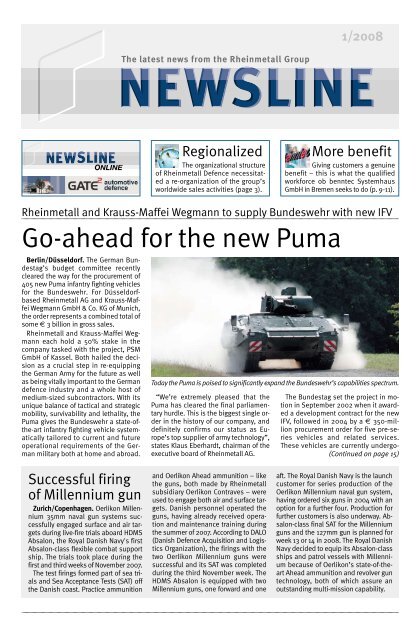
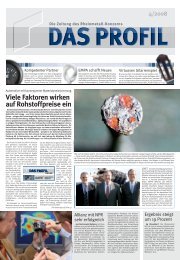
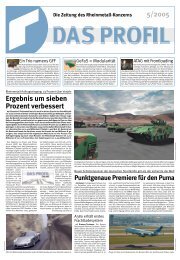
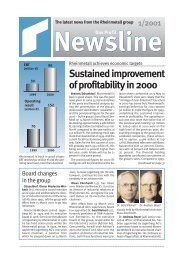

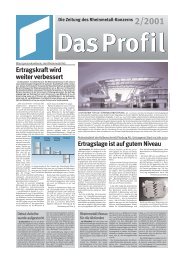
![PDF [1.0 MB] - KSPG AG](https://img.yumpu.com/5513074/1/171x260/pdf-10-mb-kspg-ag.jpg?quality=85)
